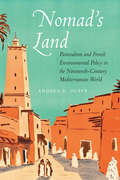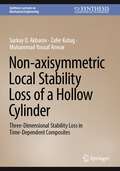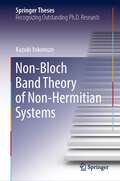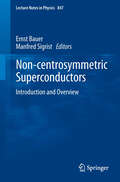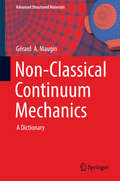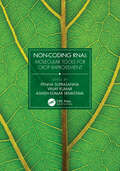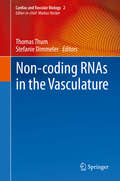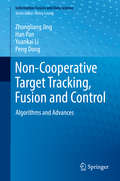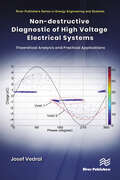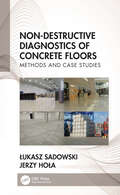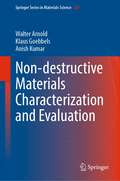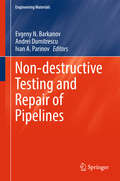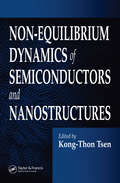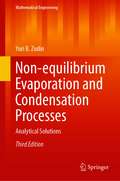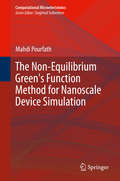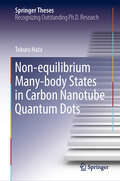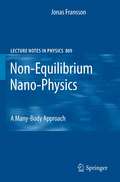- Table View
- List View
Nomad's Land: Pastoralism and French Environmental Policy in the Nineteenth-Century Mediterranean World (France Overseas: Studies in Empire and Decolonization)
by Andrea E. DuffyDuring the nineteenth century, the development and codification of forest science in France were closely linked to Provence&’s time-honored tradition of mobile pastoralism, which formed a major part of the economy. At the beginning of the century, pastoralism also featured prominently in the economies and social traditions of North Africa and southwestern Anatolia until French forest agents implemented ideas and practices for forest management in these areas aimed largely at regulating and marginalizing Mediterranean mobile pastoral traditions. These practices changed not only landscapes but also the social order of these three Mediterranean societies and the nature of French colonial administration. In Nomad&’s Land Andrea E. Duffy investigates the relationship between Mediterranean mobile pastoralism and nineteenth-century French forestry through case studies in Provence, French colonial Algeria, and Ottoman Anatolia. By restricting the use of shared spaces, foresters helped bring the populations of Provence and Algeria under the control of the state, and French scientific forestry became a medium for state initiatives to sedentarize mobile pastoral groups in Anatolia. Locals responded through petitions, arson, violence, compromise, and adaptation. Duffy shows that French efforts to promote scientific forestry both internally and abroad were intimately tied to empire building and paralleled the solidification of Western narratives condemning the pastoral tradition, leading to sometimes tragic outcomes for both the environment and pastoralists.
Non-axisymmetric Local Stability Loss of a Hollow Cylinder: Three-Dimensional Stability Loss in Time-Dependent Composites (Synthesis Lectures on Mechanical Engineering)
by Surkay D. Akbarov Zafer Kutug Muhammad Yousaf AnwarThe book presents formulations and examples of three-dimensional non-axisymmetric stability in viscoelastic anisotropic cylindrical shells. The most critical stability loss modes are determined by minimizing the critical loads and critical times with respect to the number of half-waves in radial as well as transverse directions. Currently, there is no literature available on three-dimensional local buckling analysis (or localized warpage) that considers non-axisymmetric stability loss in viscoelastic cylindrical shells. The contents of this book provide the formulation for such a stability loss analysis through the framework of the three-dimensional linearized theory of stability. Additionally, as this book addresses the problem by modeling the material as a viscoelastic fibrous composite, it can be applied to carry out buckling analysis in both elastic and viscoelastic cases.Guide to modelling composite viscoelastic shell elements for buckling analysisProvides a framework for defining the failure criterion for viscoelastic materialsCourse material for teaching shell buckling and viscoelastic composites
Non-Bloch Band Theory of Non-Hermitian Systems (Springer Theses)
by Kazuki YokomizoThis book constructs a non-Bloch band theory and studies physics described by non-Hermitian Hamiltonian in terms of the theory proposed here.In non-Hermitian crystals, the author introduces the non-Bloch band theory which produces an energy spectrum in the limit of a large system size. The energy spectrum is then calculated from a generalized Brillouin zone for a complex Bloch wave number. While a generalized Brillouin zone becomes a unit circle on a complex plane in Hermitian systems, it becomes a circle with cusps in non-Hermitian systems. Such unique features of the generalized Brillouin zone realize remarkable phenomena peculiar in non-Hermitian systems. Further the author reveals rich aspects of non-Hermitian physics in terms of the non-Bloch band theory. First, a topological invariant defined by a generalized Brillouin zone implies the appearance of topological edge states. Second, a topological semimetal phase with exceptional points appears, The topological semimetal phase is unique to non-Hermitian systems because it is caused by the deformation of the generalized Brillouin zone by changes of system parameters. Third, the author reveals a certain relationship between the non-Bloch waves and non-Hermitian topology.
Non-Centrosymmetric Superconductors
by Ernst Bauer Manfred SigristSuperconductivity in materials without inversion symmetry in the respective crystal structures occurs in the presence of antisymmetric spin-orbit coupling as a consequence of an emerging electric field gradient. The superconducting condensate is then a superposition of spin-singlet and spin-triplet Cooper pairs. This scenario accounts for various experimental findings such as nodes in the superconducting gap or extremely large upper critical magnetic fields. Spin-triplet pairing can occur in non-centrosymmetric superconductors in spite of Anderson's theorem that spin-triplet pairing requires a crystal structure that exhibits inversion symmetry. This book, authored and edited by leading researchers in the field, is both an introduction to and overview on this exciting branch of novel superconductors. Its self-contained and tutorial style makes it particularly suitable for self-study and as source of teaching material for special seminars and courses. At the same time it constitutes an up-to-date and authoritative reference for anyone working in this exciting field.
Non-Circular Journal Bearings
by Amit ChauhanThis brief details non-circular journal bearing configurations. The author describes the mathematical and experimental studies that pertain to non-circular journal bearing profiles and how they can be applied to other types of bearing profiles with some modifications. He also examines non-circular journal bearing classifications, the methodology needed to carry out mathematical modeling, and the experimental procedures used to determine oil-film temperature and pressures.
Non-Classical Continuum Mechanics: A Dictionary (Advanced Structured Materials #51)
by Gérard A. MauginThis dictionary offers clear and reliable explanations of over 100 keywords covering the entire field of non-classical continuum mechanics and generalized mechanics, including the theory of elasticity, heat conduction, thermodynamic and electromagnetic continua, as well as applied mathematics. Every entry includes the historical background and the underlying theory, basic equations and typical applications. The reference list for each entry provides a link to the original articles and the most important in-depth theoretical works. Last but not least, every entry is followed by a cross-reference to other related subject entries in the dictionary.
Non-Classical Crystallization of Thin Films and Nanostructures in CVD and PVD Processes
by Nong Moon HwangThis book provides a comprehensive introduction to a recently-developed approach to the growth mechanism of thin films and nanostructures via chemical vapour deposition (CVD). Starting from the underlying principles of the low pressure synthesis of diamond films, it is shown that diamond growth occurs not by individual atoms but by charged nanoparticles. This newly-discovered growth mechanism turns out to be general to many CVD and some physical vapor deposition (PVD) processes. This non-classical crystallization is a new paradigm of crystal growth, with active research taking place on growth in solution, especially in biomineralization processes. Established understanding of the growth of thin films and nanostructures is based around processes involving individual atoms or molecules. According to the author's research over the last two decades, however, the generation of charged gas phase nuclei is shown to be the rule rather than the exception in the CVD process, and charged gas phase nuclei are actively involved in the growth of films or nanostructures. This new understanding is called the theory of charged nanoparticles (TCN). This book describes how the non-classical crystallization mechanism can be applied to the growth of thin films and nanostructures in gas phase synthesis. Based on the author's graduate lecture course, the book is aimed at senior undergraduate and graduate students and researchers in the field of thin film and nanostructure growth or crystal growth. It is hoped that a new understanding of the growth processes of thin films and nanostructures will reduce trial-and-error in research and in industrial fabrication processes.
Non-Coding RNAs: Molecular Tools for Crop Improvement
by Penna Suprasanna Vinay Kumar Ashish Kumar SrivastavaThis reference book compiles updated research on non-coding RNAs and their role in producing high-yielding plants with higher productivity under changing climates. Plant non-coding RNAs are emerging as the key regulators of plant responses to climate change and environmental stresses. The book covers the sequencing, identification, prediction, identification, characterization, and targets of non-coding RNAs to engineer high-yielding crops. It also includes in silico tools and databases to study them. Key features: Discusses the different types of non-coding RNAs including lnc-RNAs, siRNA, microRNAs, and tasiRNAs. Covers the role of plant non-coding RNAs in epigenetic regulation of environmental stress response and tolerance. Reviews the role of non-coding RNAs under environmental stresses like drought, water logging, salinity, extreme temperature, UV, heavy metals, and xenobiotics. Explores the use of non-coding RNAs in transgenic crops and genome editing. Describes the biogenesis, history, and classification of non-coding RNAs in plants. The book provides a mix of basic and advanced information for postgraduate students, researchers, and scientists in the fields of plant molecular biology, biotechnology, food security, and agriculture.
Non-coding RNAs in the Vasculature (Cardiac and Vascular Biology #2)
by Thomas Thum Stefanie DimmelerThis book focuses on the importance of regulatory RNAs in the vasculature. The main topics discussed include the role of regRNAs in vascular development and angiogenesis, ischemic cardiovascular disease and repair mechanisms, diabetic and metabolic vascular disease, atherosclerosis and vascular inflammation, as well as diagnostics of vascular disease using circulating miRNAs. Lastly, it offers an overview of emerging topics such as microvesicle-mediated miRNA cellular trafficking and the vascular importance of long non-coding RNAs. It is an invaluable resource for academics, researchers and students working in the field of vascular biology.
Non-Conservative Systems: New Static and Dynamic Stability Criteria
by Kurt IngerleNon-Conservative Systems: New Static and Dynamic Stability Criteria summarizes the essential properties of non-conservative elastic systems (static stability and post-critical behavior), and the importance of novel stability criteria for such systems. <P><P>Beginning with the history of non-conservative systems theory, the text goes on to propose new theories regarding static stability in massless non-conservative systems, and dynamic stability in systems with mass. Experiments are included, as are computational models developed by the author, along with an extensive bibliography. This new work is a valuable new resource for those working in the area of structural stability.
Non-conventional Electrical Machines
by Abderrezak Rezzoug Mohammed El-Hadi ZaïmThe developments of electrical machines are due to the convergence of material progress, improved calculation tools, and new feeding sources. Among the many recent machines, the authors have chosen, in this first book, to relate the progress in slow speed machines, high speed machines, and superconducting machines. The first part of the book is dedicated to materials and an overview of magnetism, mechanic, and heat transfer.
Non-Conventional Hybrid Machining Processes: Theory and Practice (Manufacturing Design and Technology)
by Rupinder Singh J. Paulo DavimThis new book covers process optimization and process capability for hybrid NCMP (nonconventional machining process), and combines NCMP and conventional machining removal processes for various hybridized processes. This book is focused on understanding the basic mechanism of some of the NCMPs for their possible hybridization. This book can be used for the development of a basic framework on hybridization for the selected NCMP. The framework is further strengthened by case studies included in this book. The concept of macro-modeling for NCMP and the framework for the development of industrial standards have been outlined. This book is of interest to researchers and graduate students working in the field of hybrid NCMP, especially for the development of novel processes. Field engineers of NCMP may also use it for further process development. Features: Provides a detailed description of mechanism for different NCMPs for possible hybridization. Includes a case study on mechanism of processes. Offers a systematic approach for understanding NCMP. Covers the issues of process optimization and process capability for hybrid NCMP.
Non-Cooperative Target Tracking, Fusion and Control: Algorithms and Advances (Information Fusion and Data Science)
by Zhongliang Jing Han Pan Yuankai Li Peng DongThis book gives a concise and comprehensive overview of non-cooperative target tracking, fusion and control. Focusing on algorithms rather than theories for non-cooperative targets including air and space-borne targets, this work explores a number of advanced techniques, including Gaussian mixture cardinalized probability hypothesis density (CPHD) filter, optimization on manifold, construction of filter banks and tight frames, structured sparse representation, and others. Containing a variety of illustrative and computational examples, Non-cooperative Target Tracking, Fusion and Control will be useful for students as well as engineers with an interest in information fusion, aerospace applications, radar data processing and remote sensing.
Non-Destructive Assessment of Concrete Structures: Reliability and Limits of Single and Combined Techniques
by Denys BreysseThis book gives information on non destructive techniques for assessment of concrete structures. It synthesizes the best of international knowledge about what techniques can be used for assessing material properties (strength) and structural properties (geometry, defects...). It describes how the techniques can be used so as to answer a series of usual questions, highlighting their capabilities and limits, and providing advices for a better use of techniques. It also focuses on possible combinations of techniques so as to improve the assessment. It is based on many illustrative examples and give in each case references to standards and guidelines.
Non-destructive Diagnostic of High Voltage Electrical Systems: Theoretical Analysis and Practical Applications
by Josef VedralThis book describes the methods of signal processing used in the non-destructive diagnostics of mechanical and electrical properties of high-voltage electrical machines. Traditional and less traditional methods are given, which allow measuring the mechanical and electrical properties of these machines in order to determine their technical condition, including a description of their measurement methods. Separate chapters are devoted to the causes and methods of measuring and evaluating partial discharges arising in the insulation systems of high-voltage electrical machines. The following chapters provide an overview of the test methods used in the non-disassembly diagnostics of high-voltage transformers, rotary machines, high-voltage cables, insulators, surge arresters and circuit breakers. The book is intended for students of technical universities and experts in the field of non- destructive diagnostics of high-voltage electrical machines. The book was reviewed by Ing. Jiří Brázdil, Ph.D. MBA, Head of the HV laboratory of ORGREZ in the Czech Republic.
Non-Destructive Diagnostics of Concrete Floors: Methods and Case Studies
by Łukasz Sadowski Jerzy HołaConcrete floors should be diagnosed in order to obtain the proper durability. Non-destructive testing (NDT) methods, which have numerous advantages and are very effective for in situ testing, are recommended for this purpose. Non-Destructive Diagnostics of Concrete Floors: Methods and Case Studies offers useful NDT methods, test methodologies, and case studies. This book contains classifications of NDT methods, examines their areas of usefulness in floor diagnostics, and explains the complementarity and reliability of NDT methods as well as the need to calibrate research equipment. It presents interesting case studies of concrete floors, such as dowelled floors, floors with a top layer made of stone slabs, industrial floors, industrial floors with a top layer of polyurethane-cement, layered floors, post-tensioned floors, and cement screeds. The authors have drawn on many years of experience in both academia and the practical diagnosis of concrete floors using NDT methods.
Non-Destructive Evaluation of Corrosion and Corrosion-assisted Cracking
by Raman Singh Baldev Raj U. Kamachi Mudali Prabhakar SinghA comprehensive text to the non-destructive evaluation of degradation of materials due to environment that takes an interdisciplinary approach Non-Destructive Evaluation of Corrosion and Corrosion-assisted Cracking is an important resource that covers the critical interdisciplinary topic of non-destructive evaluation of degradation of materials due to environment. The authors—noted experts in the field—offer an overview of the wide-variety of approaches to non-destructive evaluation and various types of corrosion. The text is filled with instructive case studies from a range of industries including aerospace, energy, defense, and processing. The authors review the most common non-destructive evaluation techniques that are applied in both research and industry in order to evaluate the properties and more importantly degradation of materials components or systems without causing damage. Ultrasonic, radiographic, thermographic, electromagnetic, and optical are some of the methods explored in the book. This important text: Offers a groundbreaking interdisciplinary approach to of non-destructive evaluation of corrosion and corrosion-assisted cracking Discusses techniques for non-destructive evaluation and various types of corrosion Includes information on the application of a variety of techniques as well as specific case studies Contains information targeting industries such as aerospace, energy, processing Presents information from leading researchers and technologists in both non-destructive evaluation and corrosion Written for life assessment and maintenance personnel involved in quality control, failure analysis, and R&D, Non-Destructive Evaluation of Corrosion and Corrosion-assisted Cracking is an essential interdisciplinary guide to the topic.
Non-Destructive In Situ Strength Assessment of Concrete: Practical Application of the RILEM TC 249-ISC Recommendations (RILEM State-of-the-Art Reports #32)
by Denys Breysse Jean-Paul BalayssacThe book presents the work of the RILEM Technical Committee 249-ISC. Addressing the effective application of new recommendations for non-destructive in situ strength assessment of concrete, it provides information about the different steps of the investigation and processing of test results, until the delivery of strength estimates, and includes tables giving the minimum required number of cores in a variety of situations as well as several examples of how the recommendations can be used in practice. The book explores a topic which is of major importance, i.e. the assessment of concrete compressive strength in existing structures. This property (both mean and standard deviation) is a key input in many cases, such as the reinforcement of structures, the safety checking, the extension of service life. As the new RILEM recommendations imply a deep revision (and improvement) of field practice, the book is intended for managers of structures, structural engineers and specialists of NDT that have to answer these issues. More widely, it will benefit engineers and students who are interested in NDT and in the safety analysis of structures.
Non-destructive Materials Characterization and Evaluation (Springer Series in Materials Science #329)
by Walter Arnold Klaus Goebbels Anish KumarThis book is devoted to non-destructive materials characterization (NDMC) using different non-destructive evaluation techniques. It presents theoretical basis, physical understanding, and technological developments in the field of NDMC with suitable examples for engineering and materials science applications. It is written for engineers and researchers in R&D, design, production, quality assurance, and non-destructive testing and evaluation. The relevance of NDMC is to achieve higher reliability, safety, and productivity for monitoring production processes and also for in-service inspections for detection of degradations, which are often precursors of macro-defects and failure of components. Ultrasonic, magnetic, electromagnetic and X-rays based NDMC techniques are discussed in detail with brief discussions on electron and positron based techniques.
Non-destructive Testing and Repair of Pipelines
by Ivan A. Parinov Andrei Dumitrescu Evgeny N. BarkanovThis book describes efficient and safe repair operations for pipelines, and develops new methods for the detection and repair of volumetric surface defects in transmission pipelines. It also addresses the physics, mechanics, and applications of advanced materials used for composite repair of corroded pipelines. Presenting results obtained in the European Commission's INNOPIPES FRAMEWORK 7 programme, it develops long-range ultrasonic and phased array technologies for pipeline diagnostics, and explores their interactions with discontinuities and directional properties of ultrasonic antenna array. The book subsequently shares the results of non-destructive testing for different types of materials applications and advanced composite repair systems, and characterizes the mechanical properties by means of fracture methods and non-destructive techniques. In turn, the book assesses the currently available technologies for reinforcement of pipelines, drawing on the experience gained by project partners, and evaluates the recovery of the carrying capacity of pipeline sections with local corrosion damage by means of analytical and numerical procedures. It develops an optimization method based on the planning of experiments and surface techniques for advanced composite repair systems, before validating the numerical models developed and experimentally gauging the effectiveness of composite repair with the help of full-scale hydraulic tests.
Non-Equilibrium Dynamics of Semiconductors and Nanostructures
by Kong-Thon TsenThe advent of the femto-second laser has enabled us to observe phenomena at the atomic timescale. One area to reap enormous benefits from this ability is ultrafast dynamics. Collecting the works of leading experts from around the globe, Non-Equilibrium Dynamics of Semiconductors and Nanostructures surveys recent developments in a variety of areas in ultrafast dynamics.In eight authoritative chapters illustrated by more than 150 figures, this book spans a broad range of new techniques and advances. It begins with a review of spin dynamics in a high-mobility two-dimensional electron gas, followed by the generation, propagation, and nonlinear properties of high-amplitude, ultrashort strain solitons in solids. The discussion then turns to nonlinear optical properties of nanoscale artificial dielectrics, optical properties of GaN self-assembled quantum dots, and optical studies of carrier dynamics and non-equilibrium optical phonons in nitride-based semiconductors. Rounding out the presentation, the book examines ultrafast non-equilibrium electron dynamics in metal nanoparticles, monochromatic acoustic phonons in GaAs, and electromagnetically induced transparency in semiconductor quantum wells.With its pedagogical approach and practical, up-to-date coverage, Non-Equilibrium Dynamics of Semiconductors and Nanostructures allows you to easily put the material into practice, whether you are a seasoned researcher or new to the field.
Non-equilibrium Evaporation and Condensation Processes: Analytical Solutions (Mathematical Engineering)
by Yuri B. ZudinThis present book is concerned with analytical approaches to statement and solution of problems of non-equilibrium evaporation and condensation. From analytical solutions, one is capable to understand and represent in a transparent form the principal laws, especially in the study of a new phenomenon or a process. This is why analytical methods are always employed on the first stage of mathematical modeling. Analytical solutions are also used as test models for validation of results numerical solutions. Non-equilibrium evaporation and condensation processes play an important role in a number of fundamental and applied problems: laser methods for processing of materials, depressurization of the protection cover of nuclear propulsion units, solar radiation on a comet surface, explosive boiling of superheated liquid, thermodynamic principles of superfluid helium. Analytical relations provide an adequate description of the essence of a physical phenomenon.
The Non-Equilibrium Green's Function Method for Nanoscale Device Simulation
by Mahdi PourfathFor modeling the transport of carriers in nanoscale devices, a Green-function formalism is the most accurate approach. Due to the complexity of the formalism, one should have a deep understanding of the underlying principles and use smart approximations and numerical methods for solving the kinetic equations at a reasonable computational time. In this book the required concepts from quantum and statistical mechanics and numerical methods for calculating Green functions are presented. The Green function is studied in detail for systems both under equilibrium and under nonequilibrium conditions. Because the formalism enables rigorous modeling of different scattering mechanisms in terms of self-energies, but an exact evaluation of self-energies for realistic systems is not possible, their approximation and inclusion in the quantum kinetic equations of the Green functions are elaborated. All the elements of the kinetic equations, which are the device Hamiltonian, contact self-energies and scattering self-energies, are examined and efficient methods for their evaluation are explained. Finally, the application of these methods to study novel electronic devices such as nanotubes, graphene, Si-nanowires and low-dimensional thermoelectric devices and photodetectors are discussed.
Non-equilibrium Many-body States in Carbon Nanotube Quantum Dots (Springer Theses)
by Tokuro HataThis book presents the first experiment revealing several unexplored non-equilibrium properties of quantum many-body states, and addresses the interplay between the Kondo effect and superconductivity by probing shot noise. In addition, it describes in detail nano-fabrication techniques for carbon nanotube quantum dots, and a measurement protocol and principle that probes both equilibrium and non-equilibrium quantum states of electrons. The book offers various reviews of topics in mesoscopic systems: shot noise measurement, carbon nanotube quantum dots, the Kondo effect in quantum dots, and quantum dots with superconducting leads, which are relevant to probing non-equilibrium physics. These reviews offer particularly valuable resources for readers interested in non-equilibrium physics in mesoscopic systems. Further, the cutting-edge experimental results presented will allow reader to catch up on a vital new trend in the field.
Non-Equilibrium Nano-Physics: A Many-Body Approach
by Jonas FranssonThe aim of this book is to present a formulation of the non-equilibrium physics in nanoscale systems in terms of many-body states and operators and, in addition, discuss a diagrammatic approach to Green functions expressed by many-body states. The intention is not to give an account of strongly correlated systems as such. Thus, the focus of this book ensues from the typical questions that arise when addressing nanoscale systems from a practical point of view, e.g. current-voltage asymmetries, negative differential conductance, spin-dependent tunneling. The focus is on nanoscale systems constituted of complexes of subsystems interacting with one another, under non-equilibrium conditions, in which the local properties of the subsystems are preferably being described in terms of its (many-body) eigenstates.
